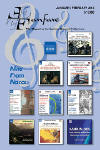Texte paru dans: / Appeared in:

Fanfare Magazine: 36:3 (01-02/2013)
Pour
s'abonner / Subscription information
Les abonnés à Fanfare Magazine ont accès aux archives du
magazine sur internet.
Subscribers to Fanfare Magazine have access to the archives of the magazine
on the net.
Harmonia Mundi
HMC902124

3149020212424
Consultez toutes les évaluations recensées pour ce cd
~~~~ Reach all the evaluations located for this CD
In Fanfare 34:2, I urgently recommended the first volume of Isabelle Faust’s collection of Johann Sebastian Bach’s Solo Violin Sonatas and Partitas for the violinist’s “intellectual energy, for her tonal strength, and for the vibrant individuality of her playing... as one of the most personal and most inventive after [Nathan] Milstein’s.” The confidence and flexibility of her projection in the opening measures of the First Sonata, coupled with the same easy nobility of tone production that characterized the first volume (again on the 1704 Sleeping Beauty Stradivari), foreshadow a completion to the series, recorded in August and September of 2011, that’s in every way equal to its opening. Both complexity and variety mark her reading: She plays the fugue lightly and quickly, brings an airy grace to the Siciliana and a combination of virtuosity and effervescence to the gigue-like Presto—like Milstein’s various readings of this sonata, this one’s hardly academic, though it probes deeply, wearing its learning lightly—and elegantly.
Faust sharpens the dotted rhythms in the First Partita’s Allemande, creating excitement in the place of mere ritual acknowledgment of the movement’s piquant-looking rhythms. Her light and liquid grace in the Double provides a perfectly balanced foil. She accents the Corrente very strongly, yet again indulges rhythmic flexibility (enhanced by a cornucopia of articulations) that preserves the movement from any hint of the mechanical; and she pairs it with a performance of the Double that gives the impression, perhaps because of the giddy clarity of her détaché bowing, of being more rapid than almost anybody’s, except maybe Ruggiero Ricci’s (teachers often advise students that evenness at a slower tempo sounds quicker than a faster irregular speed). Her double-stops in the Sarabande sound resonant and sweetly in tune, and her gloss in the Double haunting and reflective. In the Tempo di Borea, she opens the shutters to a clean, bright light, with overall crisp articulation adding definition to her feathery bow stroke, and her playing of the Double extends this manner to the end of the work.
Even those who consider the Second Sonata the most abstract of the set should be convinced by the sense of almost ruminative, improvisatory freedom that Faust brings to its Grave. Her reading of the fugue at least seems to emphasize the subject’s compact geometry less than its linear flow, yet she provides plenty of punctuation, dividing the piece clearly into contrasting if complementary sections. She doesn’t linger over nuances in the Andante’s accompanied melody, but continually moves the melody and its musical argument forward. In the final Allegro, she adopts an approach heavier than she took in the first sonata’s Presto—perhaps in order to realize its almost concerto-like virtuosity and weight.
The engineers have captured Faust up close—close enough to pick up breathing, some of it, it seems, rather heavy, although not heavy enough to serve as a distraction in such a performance. For on the whole, Faust has encompassed in this set goals (whether she explicitly adopted them or not) that have eluded so many of her contemporaries: a thoughtful individuality that’s free from quirkiness and a style of bowing that suggests the period but still exhibits an almost seductive tonal sheen. Like Milstein, in either of his recordings, this is magisterial, authoritative—and urgently recommended.
Cliquez l'un ou l'autre
bouton pour découvrir bien d'autres critiques de CD
Click either button for many other reviews


